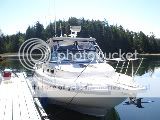Thank you for worrying about my credibility! I glad some one does, I don't!
There... is that better! I corrected my spelling and am sorry I spelled Fraser wrong, but hey, I am a Yank! If I were a Canuck, that would be un-forgiveable!
Oh, I don't have any "Academic integrity",but I did finish the 8th grade! [:I]
BTW... it is "Strait" not "Straight"!


But, your spell check wouldn't pick that up.

quote:There has been a fair chunk of genetic work completed on WCVI chinook stocks
Do you really mean "genetic work"? or " geneitic study"?? And why would there be either of "WCVI" salmon "stock", unless you are referring to the "Wild" stock, which is almost extinct? This is a question... not a statement!

Now this is a little off topic, but isn't most of the WCVI fishery comprised of salmon returning to basically the three Hatcheries located at Conuma, Robertson, Nitinat? Along with U.S. and Fraser (notice the spelling) bound fish? I know there is a wild stock on the WCVI, but it is not very strong and not much of a return?
And should not be targeted! Hence, one reason for the closures inside the surf line?
quote:The data suggest that most of the American fish migrate close to the edge of the shelf and turn the corner prior to Juan De Fuca Straight. Most (not all) of the Canadian fish migrate closer to shore. There are always exceptions,and salmon do stray among watersheds. There are certainly a few Columbia chinook heads sent in each year that were captured in Juan De Fuca and many other locations.
What "corner" prior to Juan de Fuca Strait (notice the spelling) are you referring to?

I think, to date the only clear "data" of "Chinook" migration, is they basically travel in the shaded area on the below map? "Most of the Canadian fish migrate closer to shore, first I heard of that? However, I do agree the Canadian bound, kinda have to get a little closer to shore than the U.S. bound fish. That is, if they want to get to their natal stream??[?] I also know, larger fish(both Canadian and U.S.), tend to travel closer to shore and I also know if you ask any of the guides out of Ucluelet or Bamfield, they will tell you they have caught a LOT of U.S. bound fish at Wya, Eagles Nest, Cree and even Swale, right next to shore! As well as a lot of Canadian bound fish on the banks? Did I spell all those names right?

They have Candian fish in the Gulf of Alaska? Along the Continental Shelf and U.S. fish in Howe Sound? Boy, you guys are right, I am confused?
Here is the Chinook migration area, please note this is dated 2007 and is from NOAA, unlike another link sending you to a outdated map posted on a 2004 King County, Washington website, under archives? (Chris?)
 And, when this data was compiled, there were "very few" Chinook salmon outside of the shaded area!</u> I am pretty sure they didn't get any count in the "brown areas"! [8D]
And, when this data was compiled, there were "very few" Chinook salmon outside of the shaded area!</u> I am pretty sure they didn't get any count in the "brown areas"! [8D]
Cheers!





